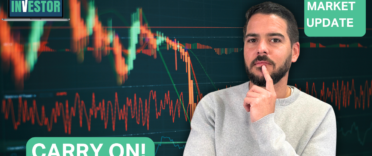Welcome to the latest episode of my monthly YouTube show where I discuss what is happening in investment markets and what to look out for. This episode I talk about how fear is creeping back into global stock markets.
Each show lasts between 5-10 minutes and is aimed at DIY investors (including novices) seeking contemporary analysis to help them understand how investment markets work.
Subscribe to my YouTube channel to receive my weekly analysis of investment markets or alternatively, you can listen via my weekly Midweek Markets podcast below.
Damien's Market Update monthly podcast
Other ways to watch, listen and subscribe
You can listen to other episodes and subscribe to the show by searching 'Money to the Masses' on Spotify or by using the following links:
Abridged transcript - Damien's Market Update - August 2023
I concluded last month’s show by stating that overall, we were heading into the second half of 2023 with the same nagging concerns that haunted markets at the start of 2023, before equity markets rallied strongly. The only difference was that more and more investors had returned to the market, chasing the equity market rally. Or in other words, greed was now trumping fear, compared to the start of 2023.
The fly in the ointment was the strength of the pound which was hampering returns not only of the FTSE 100 but also their overseas holdings when currency conversion was taken into account.
This was reflective of the main theme that has been driving stock markets throughout 2023, policy divergence between key central banks overlaid on a backdrop of concerns that bubble up into prominence periodically. These include corporate earnings concerns, Chinese growth fears and geopolitical worries. But the general trend remains in place for stock markets, whereby the closer the market believes a central bank is to the end of its policy tightening cycle, the better its domestic market has performed.
A good example, or microcosm, of this occurred in the hours after the official UK data release last month. Lower than expected data caused the FTSE 100 to soar 1.9%, the biggest one-day gain since November, and property companies' shares surged amid indications of slowing inflation and lower projected peak interest rates. But the latest UK inflation data which was released minutes before I recorded this video painted a less rosy picture. So have a look at how investment markets react in hours after the release as you learn a lot about the interrelationship between assets during these periods . But it isn’t just the stock market that has been shaken by newly released economic data, it’s also bond markets. After last month’s inflation data release the huge swing in the market's Bank of England base rate expectations saw the 10 year UK gilt yield tumble to its lowest level since early June, while the pound fell back below $1.30 to $1.288, releasing some of the pressure on UK investors.
But it wasn’t just in the UK where inflation data pleasantly surprised the markets, but also in the US which meant that any stock market dips were quickly bought during July as investors' belief grew that global central banks may have turned the corner in their fight against inflation.
But following a stellar July, which built upon an already impressive start to 2023 for global stock markets, August has started on the back foot as shown in the table below, with a weaker pound helping soften the blow a little.
| Index | August return to date |
| FTSE Eurofirst 300 | -2.46 |
| Dow Jones Composite Average | -2.76 |
| Deutsche Borse DAX 30 Performance | -2.91 |
| S&P 500 | -3.03 |
| MSCI ACWI | -3.2 |
| FTSE 100 | -3.61 |
| Nikkei 225 | -3.7 |
| Nasdaq 100 | -4.33 |
| MSCI Emerging Markets | -4.4 |
| MSCI AC Asia ex Japan | -5.07 |
So what is happening? Well, a trickier month was to be somewhat expected, not just because of the strong rally we’ve seen year-to-date, but also from a seasonality perspective. August is a notoriously tricky month for equities. Historically, the S&P 500 has fallen 0.2% on average in August since 1945. This is worse than the average performance of all other months, except for September, which has an average decline of 0.7%. There's a similar story of August weakness for the NASDAQ, which was up 37% for 2023 heading into August. It’s also a similar story in the UK, where the FTSE 100 has fallen an average of 0.4% in August since 1984.
The question becomes, will dip buyers return to rescue the stock market again, as they did at the start of July? It’s too early to say but there are some notable headwinds starting to blow. While equity markets have fared well in recent months, the same can’t be said for bond markets. The 10 year US treasury yield has exploded higher in recent weeks, almost surpassing its 2022’s high. When yields rise the price of bonds fall as do the values of bond funds. But rising yields could eventually cause a problem for the stock market. There has been a fairly tight correlation between the fortunes of the tech-heavy Nasdaq 100 and the 10 year US treasury yield over the last couple of years which has now broken down. It would suggest that if the correlation is to return then we could see either a strong rally in the value of 10 year US treasuries or a collapse in US tech stocks. Right now we are seeing more of the latter.
The US dollar index has also woken from its slumber and has rallied significantly. And when the direction of the US dollar index changes, we usually see a ripple effect across other assets. For example, if the US dollar index keeps rising then it will continue to be another headwind for US stocks.
However, we have seen some rotation into defensive equity sectors globally, which may be a lifeline for the current bull market in stocks. Also the weakness we’ve seen could just be reflective of a bout of profit-taking after such a strong start performance in 2023. But investors’ nerves are starting to show. The CNN Fear and Greed Index was showing extreme greed was driving markets just a month ago when I made my last video, now we are almost back to a neutral balance between fear and greed. Data out of China suggesting the economy is slowing and credit downgrades by rating agencies for certain US banks has added to investor jitters. If the bears are to drive this market lower then now’s their chance.



